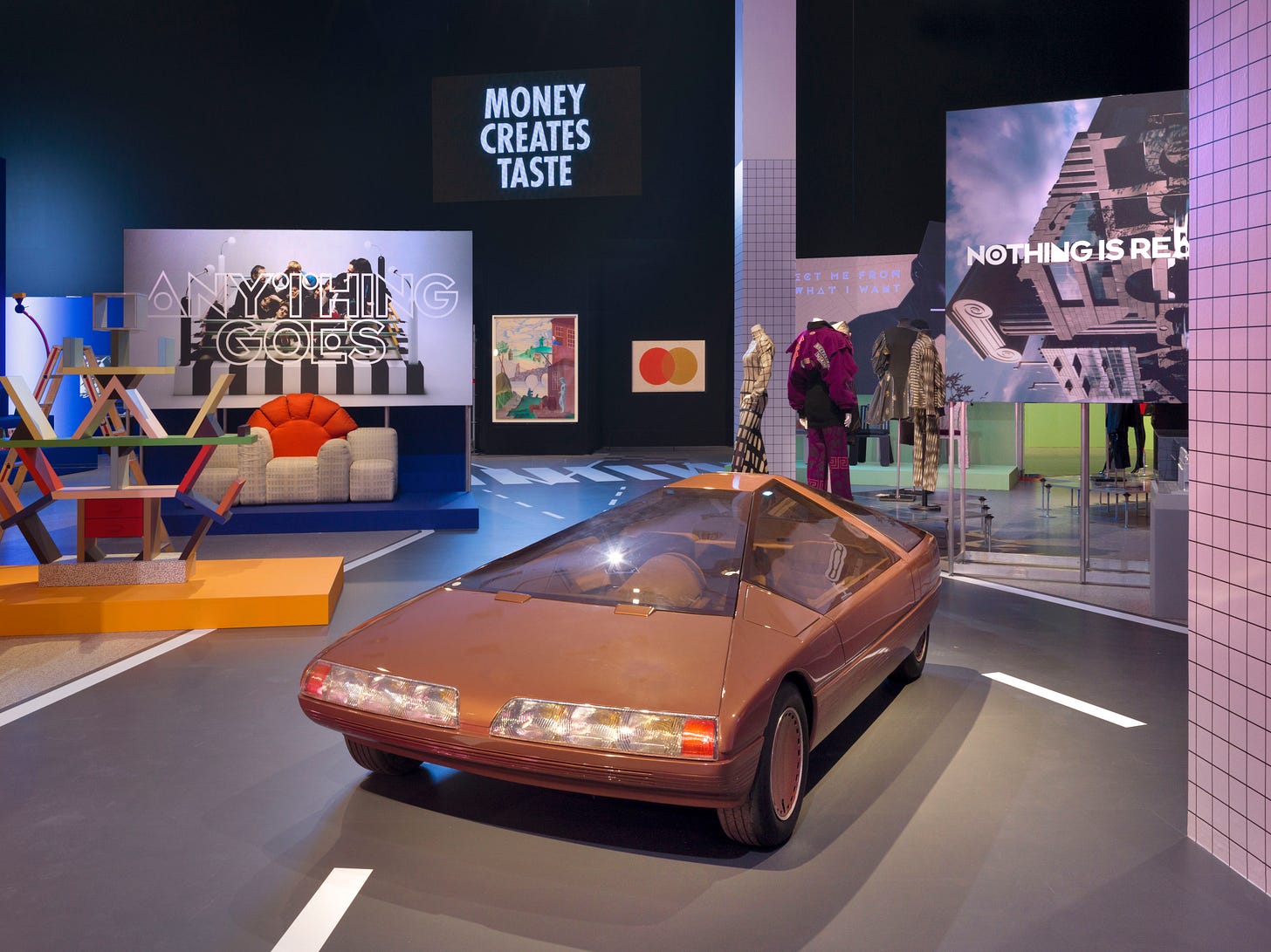Capitalism really popped off this one: Post-Modernism at Bundeskunsthalle Bonn
From "Obey authority! Follow the rules!" to "Follow your heart!" - this was the beginning of Post-Modernism, one international creative playground. A flawless world? The show leaves me questioning.
It’s Fun Fun Fun Fun Fun!
The very first small room you enter immediately sets the vibe: Music videos from the ‘70s and ‘80s are screened on a wall. Bored? Ain’t nobody got time for that! Just press the big red button with WEITER [NEXT] written on it: A new video starts immediately.
It looks like anything but an art exhibition: Billboards hover over the brightly colored space, flashy furniture is arranged as in a pop-up design store, medical pills and the word AIDS in the style of Robert Indiana (1928-2018, American) are turned into wallpaper, glass displays are filled with kitchenware, retro tech, and models of unreal buildings. German ‘80s Pop music blasts from a room turned into an alternative nightclub. If anything, this show is rather an upbeat shopping mall, a trade fair, an amusement park, or the backstage prop collection of a Broadway theater. It can be anything you want it to be. This is Post-Modernism.

Post-Modernism: The Good Ending?
Curators Kolja Reichert (Millenial, German) & Eva Kraus (Gen X, German) bring together furniture, art, architecture, movies, music, and gadgets from all around the world. The timeframe of the show is sandwiched between The Moon Landing (1967) and the publication of Francis Fukuyama’s book “The End of History and The Last Man” (1992). While The Moon Landing fueled a belief in infinite growth and expansion, Francis’ book painted a picture of the most certain future after the end of the Cold War and the fall of the Soviet Union: capitalism wins, world peace, no more history. Needless to say: sike!
Although things turned out slightly different, Francis’ idea of how the 20th century might end reflected the beliefs of a Post-Modernist society of how this is the world as it’s exactly supposed to be. Mark Fisher described this very well in his book “Capitalist Realism” (2009), explaining that “it’s easier to imagine the end of the world than the end of capitalism” (Chapter 1).

The freedom to make money
There is a difference between criticizing and critiquing. Criticism comes from beyond, critique comes from within. Criticism dismantles structures, critique keeps them in place. Criticism demands equal opportunities. Critique proposes an exhibition about inequality (and makes extra cash off it).
The exhibition does not dismiss the conversations and ideas that emerged contrary to the Post-Modernist euphoria. As Black emancipation movements in the ‘60s and ‘70s gained attention, writer Roland Barthes proclaimed the death of the author: Who cares about who said it? Let’s care about the words, not the voice! Black feminist author bell hooks called out this development in her book “Postmodern Blackness” (1992). And yet, the contextualization of consumerism, the new free market economy, the rise of media, and the obsession with more is more appear matter-of-factly throughout the show with an innocent shrug.
Post-Modernism doesn’t know nationalities or local communities. Everything becomes a potential sample waiting to be remixed and mashed. The freedom of abandoning the categories of high and low, art and not art creates new possibilities of expression. But this freedom comes at a high price if everything is legitimized only through whether you can capitalize on it. That’s the catch: There’s no art for art’s sake. It’s art for profit’s sake.
Even criticism is swallowed up and becomes part of Post-Modernism. Jenny Holzer’s (Baby Boomer, American) iconic billboards and their political content fold in front of the inescapable pull of consumerism (I wish there was a Barbara Kruger work in the show!!!). The enlarged copy of Edward W. Said’s book “Orientalism” (1978) looks rather like an object from Alice in Wonderland than a crucial text on global political power structures.

The Sex Pistol’s 1979 album cover for The Great Rock 'N' Roll Swindle perfectly sums it up: The artist is just a prostitute working for its pimp. Everything that can make money will be milked in Post-Modernism. The tragedy of the AIDS crisis sits side by side with fun mirrors you can take pictures in front of. Absurdity is all around. Awareness becomes irony. Post-Modernism looks at criticism and crisis saying: “Oh no…! Anyways…”
The Post is in any case what describes our lifetime: Post-identitarian, post-factual, post-national. Kolja & Eva leave it up for discussion whether we are still stuck in Post-Modernism or, if you will, whether we entered some sort of Post-Post-Modernism.
You can go back to the Future and see ALLES AUF EINMAL: DIE POSTMODERNE, 1967—1992 until January 28, 2024 at Bundeskunsthalle Bonn.
Bundeskunsthalle
Museumsmeile Bonn
Helmut-Kohl-Allee 4
53113 Bonn
Open Tuesday, Thursday to Sunday 10 am until 7 pm, Wednesday 10 am until 9 pm
Entry varying
Website
In the mood for some retro funk? Stay up to date by subscribing to this substack and sending this review to a friend. Sharing is caring :)
See you soon!
Jennifer
The Gen Z Art Critic





Such an interesting breakdown! I live relatively close, might make a visit 🤔